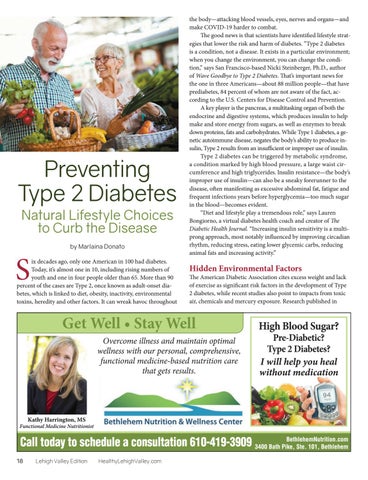Natural Lifestyle Choices to Curb the Disease
S
by Marlaina Donato
ix decades ago, only one American in 100 had diabetes. Today, it’s almost one in 10, including rising numbers of youth and one in four people older than 65. More than 90 percent of the cases are Type 2, once known as adult-onset diabetes, which is linked to diet, obesity, inactivity, environmental toxins, heredity and other factors. It can wreak havoc throughout
Hidden Environmental Factors
The American Diabetic Association cites excess weight and lack of exercise as significant risk factors in the development of Type 2 diabetes, while recent studies also point to impacts from toxic air, chemicals and mercury exposure. Research published in
Get Well • Stay Well Overcome illness and maintain optimal wellness with our personal, comprehensive, functional medicine-based nutrition care that gets results.
High Blood Sugar? Pre-Diabetic? Type 2 Diabetes? I will help you heal without medication
Kathy Harrington, MS
Functional Medicine Nutritionist
BethlehemNutrition.com Call today to schedule a consultation 610-419-3909 3400 Bath Pike, Ste. 101, Bethlehem 09-15
18
Lehigh Valley Edition
HealthyLehighValley.com
ndab creativity/AdobeStock.com
Preventing Type 2 Diabetes
the body—attacking blood vessels, eyes, nerves and organs—and make COVID-19 harder to combat. The good news is that scientists have identified lifestyle strategies that lower the risk and harm of diabetes. “Type 2 diabetes is a condition, not a disease. It exists in a particular environment; when you change the environment, you can change the condition,” says San Francisco-based Nicki Steinberger, Ph.D., author of Wave Goodbye to Type 2 Diabetes. That’s important news for the one in three Americans—about 88 million people—that have prediabetes, 84 percent of whom are not aware of the fact, according to the U.S. Centers for Disease Control and Prevention. A key player is the pancreas, a multitasking organ of both the endocrine and digestive systems, which produces insulin to help make and store energy from sugars, as well as enzymes to break down proteins, fats and carbohydrates. While Type 1 diabetes, a genetic autoimmune disease, negates the body’s ability to produce insulin, Type 2 results from an insufficient or improper use of insulin. Type 2 diabetes can be triggered by metabolic syndrome, a condition marked by high blood pressure, a large waist circumference and high triglycerides. Insulin resistance—the body’s improper use of insulin—can also be a sneaky forerunner to the disease, often manifesting as excessive abdominal fat, fatigue and frequent infections years before hyperglycemia—too much sugar in the blood—becomes evident. “Diet and lifestyle play a tremendous role,” says Lauren Bongiorno, a virtual diabetes health coach and creator of The Diabetic Health Journal. “Increasing insulin sensitivity is a multiprong approach, most notably influenced by improving circadian rhythm, reducing stress, eating lower glycemic carbs, reducing animal fats and increasing activity.”




